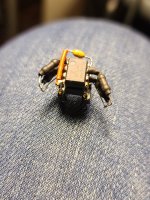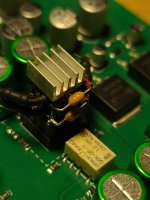Fun with op amps. I present, the "Bug". Stacking is nothing new but these stacked ne5532 op amps are playing very nicely with each other. Will have a vid with proper audio examples this week.
Attachments
The soldered stack presents a wonderful opportunity to surreptitiously introduce a placebo into the listening tests.
100 ohm resistors on pins 1 and 7 and a .1 microfarad cap across + and - pins 4 & 8.What is the schematic of that?
With caps and resistors this is running cool. with no resistors the outputs will have a battle royal.Tried that before...the dc offset make them run at huge idle currents which ask for heatsinks .They sound good as they run in pure class A, but they actually run at the upper limit of output dc current they can output and not sure how long will they last.
You get similar sound if you naturally idle them at 2...5 mA instead of paralleling them the wrong way at 40 mA each.
Clearly the wrong way to go.
He even says that in a previous video. It works and sounds great, not forcing anyone to try it. Not sure where you are going with this.
Yes, master and slave op amps will run cool. I think you've totally missed the point, mine run cool, the heat sink is just a safety to avoid a chimney effect and they sound great.
He will tell you **** smells wonderful and is tasty as a michelin restaurant dish, because he sells those.... Also, not his invention...He even says that in a previous video. It works and sounds great, not forcing anyone to try it. Not sure where you are going with this.
Last edited by a moderator:
Another ciao.He will tell you $hit smells wonderful and is tasty as a michelin restaurant dish, because he sells those.... Also, not his invention...
Those paralleled opamps from company Virtual HiFi are running very hot, they know what to charge for their products though. :)Not my invention. Just running with it and so far, great results. Greg has great vids on his Virtual HiFi YouTube channel.
Below link to my earlier post there's an IR picture attached showing how hot those are running with the heatsinks on.
Seems the audiophile opamp scene have gone a full circle from IC's to discrete and now back to IC's, VirtualHiFi thinks they have found a solution using lots of opamp IC's in parallel:
Recently, discrete Op Amps became popular.
Since they are built with individual components, many consider them to be better-sounding than the regular integrated Op Amps we know very well.
I agree. I tested many different Op Amps, and the discrete ones always truly shined and sounded superior.
However there is one trick that can be done with...
Well...so far zero heat issues and sounds great. He is smart to have heatsinks for enclosed cases. Yup, saw all his info and even his warnings. After I post actual samples, if people hate it fine, in the meantime I will simply ignore anymore folks that don't actually want a discussion.
Is there anything you would like to discuss?
Is there anything you would like to discuss?
Only thing i could think of is higher current outputThe soldered stack presents a wonderful opportunity to surreptitiously introduce a placebo into the listening tests.
Yes, now we are talking. This is why Greg from virtual HiFi also pursued this. I did a vid on how a Sparkos op amp swap worked, and it worked extremely well. Not the same thing at all, but for the folks that can't hear the difference between op amps, I recommend a critical listening class or a hearing aid. Not directed at you, just the folks that judge without listening or have zero ability to discern differences.
@jazzboy sure keep on with your project, could you perhaps measure the voltage over those 100R's output resistors at standby, ie no input signal, that would show how much DC offsets there is.
As for Virtual HiFi I have no idea what they are doing to make the opamps draw so much current, but guessing they loaded the output so the opamps run in Class A.
As for Virtual HiFi I have no idea what they are doing to make the opamps draw so much current, but guessing they loaded the output so the opamps run in Class A.
The urge to make analogies to political discourse.Please folks, if you decide to reply like a rude imbecile, the ignore button is ready and armed.
FWIW in the Yamaha TX950 they paralleled the two halves of an NJM 2068 dual opamp. They did it to lower the noise. I suspennt there are other chips with low enough offset and close enugh match to get away with this. They would most likely be recent chips on new processes where everything is a much closer match.
Will do next swap. I am using the same value resistors as in his photos and from reading, the .1 micro arrad was chosen. So not sure the heat. But!!!!! I am using the setup in a phono pre.@jazzboy sure keep on with your project, could you perhaps measure the voltage over those 100R's output resistors at standby, ie no input signal, that would show how much DC offsets there is.
As for Virtual HiFi I have no idea what they are doing to make the opamps draw so much current, but guessing they loaded the output so the opamps run in Class A.
The resistors are used as buffers between the outputs of the op amps. Tons of info on doing that.FWIW in the Yamaha TX950 they paralleled the two halves of an NJM 2068 dual opamp. They did it to lower the noise. I suspennt there are other chips with low enough offset and close enugh match to get away with this. They would most likely be recent chips on new processes where everything is a much closer match.
- Home
- Source & Line
- Analog Line Level
- Stacked opamps


